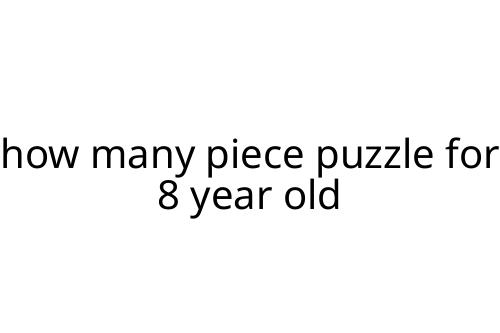how many piece puzzle for 8 year old
Puzzles aren’t just fun—they’re also great for a child’s development. If you’re shopping for a puzzle and wondering how many piece puzzle for 8 year old is appropriate, you’re in the right place. Let’s break down what makes a good puzzle for this age, what to look for, and offer a few tips to help you choose.
Age and Skill Level
By the age of 8, most children have developed strong problem-solving and spatial reasoning skills. They enjoy a challenge but can get discouraged if something is far too difficult or boringly simple. Typically, an 8-year-old is ready for puzzles with anywhere between 100 and 300 pieces.
For kids who have tackled lots of puzzles already, higher piece counts—say, up to 500—are possible, especially if the puzzle image is clear and the pieces are not too small. If your child is new to jigsaws or tends to lose focus easily, start closer to 100 pieces.
Factors to Consider
Picture Complexity and Size
A bright, distinct picture makes a puzzle easier to complete. Choose themes your child enjoys—animals, space scenes, famous landmarks. If a puzzle has a lot of similar colors or detailed artwork, stick to a lower piece count at first.
Piece size also matters for comfort and dexterity. Standard-sized pieces are perfect for 8-year-olds—not tiny, but not chunky like those made for toddlers.
Personal Interest
The best puzzle is one your child wants to finish. Involve them in picking out the theme or image. A motivated child will stick with a challenging puzzle much longer.
Cooperative vs. Solo Play
Some 8-year-olds love doing puzzles together with family or friends. If you plan to make it a group activity, you can go bigger and try puzzles with 500 pieces (and up). For solo puzzle time, stay closer to the 100–300-piece range for a reasonable challenge.
Pros and Cons of Different Piece Counts
100–150 pieces:
- Pros: Quick to complete, less frustration, encourages confidence
- Cons: May be too easy for kids with more practice
200–300 pieces:
- Pros: Good challenge, develops attention span, feels rewarding to complete
- Cons: Can take multiple sessions, may need some parental help at first
500 pieces:
- Pros: Offers a serious challenge, best for kids who love puzzles or want to work with others
- Cons: Can overwhelm some kids, patience required
Practical Tips
- Look for puzzles labeled for ages 8+ as a starting point.
- Read product reviews to confirm if other parents found the puzzle well-suited for this age.
- Store puzzles in labeled bags or boxes—a lost piece can be a big disappointment.
Bottom Line
For a typical 8-year-old, a puzzle with 100 to 300 pieces hits the sweet spot: challenging but not frustrating, fun and engaging rather than tedious. Remember, interests and abilities differ. The best way to choose is to match the puzzle’s piece count with your child’s experience and excitement level. That’s how you make puzzle time both rewarding and fun.


